RATTLEJAG MORRIS
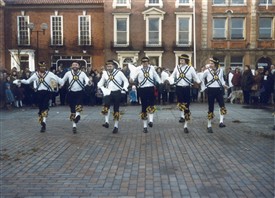
Broadstone Morris, Boxing Day 1981 in Retford Market Square, after the hunt had moved on
Rattlejag Morris
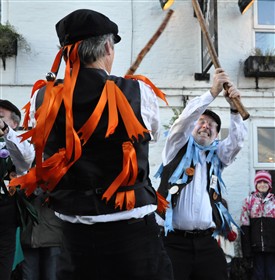
Chris Rose and Sam Millard, founder members, dancing The Turk's Head, a stick dance composed by Broadstone Morris, on Boxing Day 2010 at the Blacksmith's Arms, Everton
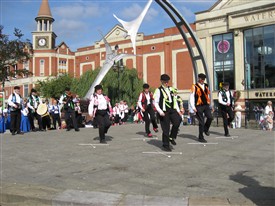
The Bacca Pipes "danced over" here were originally clay smoking pipes. Lincoln 2006.
Rattlejag Morris
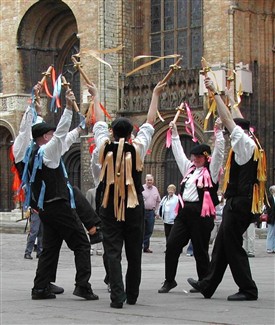
The Golden Ball dance, called after a pub in Worksop where morrismen performed in the C19th - here at Ely Folk Festival 2003.
Rattlejag Morris
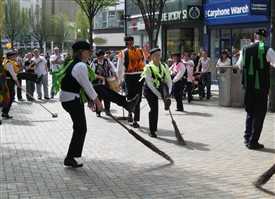
A Lincolnshire Broom Dance in Nottingham, April 2010
Rattlejag Morris
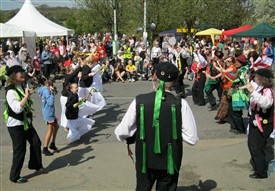
The audience at Ollerton's St George's Day Festival join in the last "Rattle Off" dance, with Malcolm Smith playing the melodeon in the foreground - April 25th 2010.
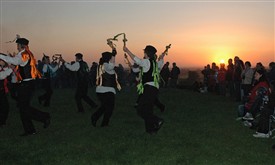
Dancing "Castle Hill" at Laxton castle mound, sunrise at 5.28 am on 1st May 2011
Rattlejag Morris
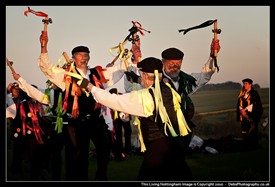
Rattlejag dance in the first summer sunrise at Laxton castle, 1st May 2010
Debbie Davis
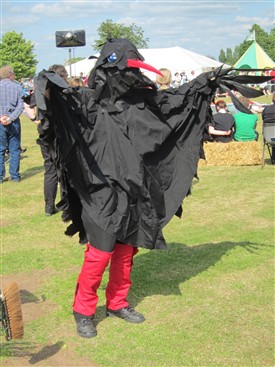
Rattlejag Morris has adopted Broadstone's Chough as its "beast" - three choughs appear on the Retford Coat of Arms.
Rattlejag Morris
A new folk art for the North shires rooted in tradition
10th Anniversary - 2002-2012
1. Rattlejag - a new morris for Nottinghamshire
Local people might have noticed over the last decade a new phenomenon - namely strangely-dressed people with coloured faces dancing to an array of strange sounds and instruments. If you have, then it's probably the region’s Rattlejag Morris!
www.rattlejagmorris.org.uk
Most people think of morris dancing as being done by men in flower bedecked hats, white shirt and bells, and are not aware that there are different types of morris dance. What most people picture are dancers performing “Cotswold” morris, usually done with either handkerchiefs or sticks. These dances were largely collected at the turn of the century from villages in Oxfordshire and Gloucestershire – the region known as the “South Midlands”. In addition there are dances from the Welsh borders from around the Shropshire area – “Border Morris”. Here the dancers black their faces and dance a much less elaborate dance form but with lots of energy and oomph. Other types are “North West” Morris from Lancashire and Cheshire and “Molly” dancing from East Anglia. Sword dances from the north east and Yorkshire are also classified as “morris”. Unlike any others are the unique forms of the Abbot’s Bromley Horn Dance, from Staffordshire, and the Britannia Coconut Dancers from Bacup in Lancashire, both with their own special annual ceremonies steeped in tradition – and also Rattlejag Morris, who hope that our distinctive “North Shires” / “Trentside” brand of morris dancing will gain national recognition in the same way one day.
Rattlejag is a mixed dance side which was formed in January 2002 by members of the men’s Cotswold morris side, Broadstone Morris, of Retford and Oaks and Acorns, a ladies North West morris team from around Winthorpe, near Newark, and other interested folk. The aim was to revive and develop a dance tradition based in our own local area. The side practice in Retford, but members come from across the region. In 2012, we have well over twenty dancers and five or more musicians involved with the side. Over the last decade, the side have danced at a wide range of events and festivals locally and far afield, such as Suffolk, Warwick, Fleetwood, York and places in between – and even on to TV. In 2012, the side will be visiting Emmendingen, Germany, with Newark Twinning Association.
2. The origin of the name: “Rattlejag Morris”
Mummers and morris dancers – performers of folk plays and dances and usually made up of local farm workers – were often termed plough “jags”, or ploughjacks, from Yorkshire down to Suffolk on the rural east side of the country. Their performances were often associated with the January Plough Festivals. We know that in our region they often employed “rattles” to enhance the dance. So the name was formed.
3. The Dances
The dancing we do is very different from that usually associated with most ‘morris dancing’. One feature is that we use a variety of rattles and shakers to give each dance its own distinctive sound. Davenport’s references in Holderness indicated the dancers played or rattled bones or waved flags during some of the dances. So we improvised, as the farm workers of old probably did too. Some of our dances feature bell-sticks to which long ribbons are attached; in others we have invested in a range of castanets/clickers and goat’s toe-nail shakers (honestly) which give distinct sounds to the different dances.
As the side has developed, we have cultivated a style of dancing firmly based in our local area and now possibly have the widest repertoire of any morris dance side – all relating to our region. We have absorbed three stick dances into our repertoire developed by Retford’s Broadstone Morris, on the basis that they are distinctive, add variety and were composed by locals in our region in the past. We have also developed a variety of morris dances with rattles and shakers.
Our local research (see local morris records section on the web) showed that broom dances were widely danced in Lincolnshire , Ethel Rudkin, for example, refers to a team of eight dancing with broomsticks. Rattlejag have now developed three dances with brooms and we also have our own bacca pipes dance (the long-stemmed pipes, danced over on the ground, were once clay smoking pipes). The local records also describe sword dances being widely done across our area. Again using the recorded material as a starting point, we now have two sword dances which are quite distinctive from those done by other sides. We continue to look for new ideas and sources for new dances. Occasionally we add a little clog step dancing, which we have also traced back to Retford, Worksop and Lincolnshire .
4. The Music
Our musicians, at the same time, were looking for local tunes which we could fit to the dances. Amongst them are the quicksteps from Newark , Louth and Market Rasen. Music is provided by fiddle, melodeon, concertina, pipes, hurdy gurdy, whistles and bassoon, supported by a percussion section. We were fortunate in being able to get a lottery grant which enabled us to purchase a set of Leicestershire bagpipes and the hurdy gurdy.
Much of our music is taken from the Lincolnshire Collection, tunes from a variety of sources, collected in Tealby (Lincolnshire) between 1823-1826 by Joshua Gibbons a papermaker. The collection was presented to the Scunthorpe museum at Normanby Hall in 1963 and in 1969 a copy was noticed by SueCave, visiting for an orchestral concert. Through her the Grimsby-based folk groups "The Meggies" and ''The Broadside" revived some of the tunes, but until Dr Robert Pacey improved the transcriptions in 1976, the manuscript remained a little known treasure of Lincolnshire’s musical heritage.
To suit the creation of new dances, Malcolm Smith has written some new tunes based on the Lincolnshire style of music. We recently found a copy of a song, “The Nottinghamshire Poacher”, but no other vernacular music that can be associated with Nottinghamshire has been traced so far, in spite of the fact that Dr Johnson, on a visit to Newstead Abbey, commented on the excellence of Nottinghamshire Hornpipes.
Ø If you know anything more, Rattlejag would love to hear from you. Please see contact details at foot of page.
5. Local Morris Research
Back in the early 2000s, we decided to have a go at researching what type of dance might have taken place in our own area and then to use this as a basis to develop a dance style unique to our region. This coincided with the publication of a book 'Forgotten Morris' by Paul Davenport. Paul had been researching “lost morris” dances in Yorkshire and his book contained details of three, two from Holderness and one from Snaith near Doncaster. At the same time, we discovered an essay written in 1960 by a Mrs Clarke of Ranby who entered a competition to write about her childhood memories. About the 1880's she wrote....
“..the morris dancers gave up over 65 years ago. In the winter months..busy practising for Christmas time when they would visit farm houses... the farmers invited their men and wives to watch. ...morris dancers were always very popular.”
We continued our search finding references to dancing in Worksop:
“Some stir was occasioned on Monday by the appearance of a company of morris dancers in the streets of Worksop. The dancers went through the old and quaint performance in a very pleasing manner.” '(Retford and Worksop Guardian 1875).
Broadening the search, we have found references to dancing right across Nottinghamshire and Lincolnshire . It appears that the dancing survived longest in connection with the celebrations that took place on Plough Monday in January. Herring describes a procession: “morris dancers paraded Caunton and other villages nearNewark.. “. (Nottinghamshire Guardian, 9/1/1925)
Washington Irvine, the American author, visited Newstead Abbey in 1835 and described seeing morris dancers alongside the ploughjags who performed the plough play:
“ ... to these succeeded a set of morris-dancers, gaily dressed up with ribands and hawk's bells. In this troop we had Robin Hood and Marian, the latter represented by a smooth- faced boy; also Beelzebub with a broom and accompanied by his wife Bessy a termagant old beldam.”
Lewellyn Jowitt, writing about old Nottinghamshire in 1853, said “maypoles and morris-dancing were formerly very general.... was generally prevalent throughout this county (Notts)”. Numerous references tell us that morris dancers were often in trouble with the authorities. In 1618 dancers were fined for dancing on the Sabbath at Trowell. The dancers came from Wollaton and Bradmore and their pipers from Ruddington and Wysall.
Again in 1844, “the morris dancers amused the good folks ofLincolnwith their tomfoolery on Plough Monday and levied contributions on all who were silly enough to part with anything on such a call. The magistrates have forbidden the people to beg and have placed strict injunctions with regard to some of whom may beg from want, why ribbon-bedecked sword carrying buffoons and ruffians should not come within the bounds of the restrictions does not seem plain; they do not beg from necessity, bit for the sake of getting money to spend in riot and excess .” (Lincoln, Rutland and Stamford Mercury, 12/1/1844)
All the evidence suggests that morris dancing was widespread in this area in the seventeenth and eighteenth centuries, but began to become less common after about 1840, so that by 1898 Thomas Radcliffe of Worksop was writing:
“the dear old morris dancers are all dead. At any rate Worksop knows them not. It is some years since the last set of morris dancers performed in Golden-Ball square... ” (Retford and Worksop Guardian).
However, further north at Snaith and east in Holderness it lingered longer lasting into the 1920's and 30's.
There are references in the early twentieth century to “morris dancers” in Nottinghamshire, but these were most likely to be the local plough players or ploughjags,who were often referred to as morris dancers even though the only dancing they might have done was as a comic turn in the play.
Our new Retford group felt confident in using the three dances from Yorkshire as a starting point, as all the Nottinghamshire references suggested a common link with the area further north. Perhaps the most exciting reference we had came from Doncaster ...
“The most remarkable modern occasion on which the morris-dance was seen to best advantage ...... was witnessed inDoncasterin 1822. The performers numbered above twenty, male and female. They came from Nottinghamshire. They were fantastically attired in dresses of every variety of colour, with a profusion of ribbons. They belonged to a station in life above that of the artisan and mechanic. They were accompanied by a band of music playing appropriate melodies. A sight so novel excited universal attention.” (Hatfield)
Ø We would love to hear from anyone who has come across any references or quotes about morris, folk or mummers dance or music in the county – however small. Please contact us via the link at the bottom of page
Ø There is an archival picture of “morris dancers” in Newark in the 1930s – does anyone know anything about this group? If so, Please contact us via the link at the bottom of page.
6. The Kit or Costume
Many of the accounts recorded the costumes once worn by the dancers and there is a similarity between them. At Snaith, the dance was led by a man wearing a pair of bull’s horns. In all the references, the dancers disguised themselves by colouring their faces either with soot or coloured clay. The references suggest lots of coloured ribbons flowing from shirts and hats (see our costume records webpage).
We decided each dancer should choose one colour for their ribbons and face paint which together would give the side a multi-coloured effect. We wear collarless shirts, black trousers and waistcoats, which reflect the clothes worn by ploughmen in the nineteenth century. To the waistcoats coloured ribbons are sewn.
Ø Has anyone noted any old photographs or pictures of traditional dances/dancers/musicians in Nottinghamshire? If so Please contact us via the contact details at the bottom of page.
7. A Living Tradition
Rattlejag has established its own “living traditions” too. On 1st May the side and its supporters gather before dawn on the site of the motte-and-bailey castle in a field by the ancient village of Laxton – and sing and dance in the first sunrise of the summer, c. 5.28 am, in true Beltane custom. They even have fires in the form of barbecues, for which to prepare an early breakfast of bacon butties to go with the beer. In 2011, over 200 visitors joined them on the top of the castle mound.
Every Boxing Day, there is a Tour of a couple of Nth Nottinghamshire pubs and, even with the severe winters of recent years, there never fails to be a cheery crowd waiting for us. In 2012, the side will call at the Blue Bell in Gringley-on-the-Hill at noon, then move on to the Blacksmith’s Arms in Everton, after which there will be music in the pub. The team also find time every summer to dance out at various hostelries, usually on Friday evenings, as is the ancient habit of morrismen. These particular rituals were started by Broadstone Morris, so have been happening in the Retford and Newark areas for over 30 years now. The side also support traditional Plough Sunday and plough play events in January and May-time festivities.
The side respects and is proud of the links to history and tradition, but feels it is very much of the “here and now”, creating new material for the times. The members are no longer all farm workers as of yore (or all men!), their performances are not restricted to particular dates or spaces and they entertain a much wider community – what, where and how they (and other morris sides) dance reflects this and so morris dance is very much alive and vibrant as a living, ongoing tradition for the 21st century.
Spin-off communal activities include traditional music sessions, ceilidh (folk) dances and social gatherings. And Rattlejag have their own in-house team archivist, recording today’s activities for tomorrow’s historians.
Rattlejag practice from September to April in Grove Street Methodist Hall in Retford on Mondays from 8.30 pm (continuing a 32 year association of English dance with this hall) –– and the dancers still go around to their “local”, the Turks Head, afterwards. The summer period especially is filled with opportunities to “dance out” at folk, dance, music and other festivals, community events, county fairs, weddings, and celebrations not only in our region, but nationally – including unusual ones like vintage car rallies, a Pimm’s Summer Party, a motor caravan merchant’s open day, an RAF family day, and a brief flurry of fame on TV! It has been a very interesting and enjoyable journey so far.
New recruits are always welcome, especially anyone who hasn't danced before (and we would like a few more men, just for balance you understand!) - it's a great way to keep fit. And potential musicians interested in dance are also invited to get in touch.
Further details of our historical research, our music, dances and calendar, as well as video and photo records of our decade of performances, can be found on our website http://www.rattlejagmorris.org.uk/
Rattlejag morris can be contacted at enquiries@rattlejagmorris.org.uk or telephone Jayne, our “Bagman”, on 01522 703510.
Chris Rose, Squire and Researcher
Malcolm Smith, Music Director and Webmaster
Moira Ruff, Publicity Officer
May 2012
_______________________________________________________________________
Bibliography
Chandler , Keith (1993) Ribbons, Bells and Squeaking Fiddles: The Social History of Morris Dancing in the EnglishSouth Midlands1660-1900. Hisarlik Press
Davenport , P. (1993) The Forgotten Morris: An investigation into Traditional Dance inYorkshire..
Hatfield, D. (1866). Historical Notes ofDoncaster, Vol. 2. p. 296
Jowitt, L. (1853), “On Ancient Customs and Sports of the County of Nottingham ” in Journal of the British Archaeological Association (JBAA), viii, 1853, p 238
Peck, W. (1815) A History of the Isle of Axholme.
Sumner, Peter D (Ed) (1997) TheLincolnshireCollections Volume 1 (The Joshua Gibbons Manuscript). ISBN 9780953011704. Dave Mallinson Publications (MB.A0102).
Archived Material
Alex Helm Collection, SheffieldUniversity.
Dolphin Morris, Nottingham / Nottingham Borough records
Ethel Rudkin (1893-1985) MemorialCollection: NorthLincolnshireMuseum
Folk Music Journal. English Folk Dance and Song Society (EFDSS)
Mansfield Advertiser
Nottinghamshire Guardian
Retford and Gainsborough Times
www.nottshistory.org.uk